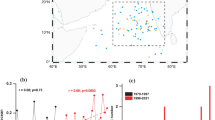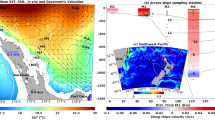Abstract
THE suggestion by C. S. Ramage1 that, in low latitudes, winds and consequently vertical motion and weather cannot be deduced from the pressure distribution is not new and is at present generally true. The coriolis force is small in low latitudes and vanishes at the equator, but the horizontal pressure forces are also normally small. If the pressure distribution is steady a large measure of balanced flow could be achieved under certain conditions. The smallness of the coriolis force only implies that it takes correspondingly longer than in middle latitudes to effect adjustment.
This is a preview of subscription content, access via your institution
Access options
Subscribe to this journal
Receive 51 print issues and online access
$199.00 per year
only $3.90 per issue
Buy this article
- Purchase on SpringerLink
- Instant access to full article PDF
Prices may be subject to local taxes which are calculated during checkout
Similar content being viewed by others
References
Ramage, C. S., Nature, 201, 1206 (1964).
Johnson, D. H., and Morth, H. T., Mem. East African Met. Dept., Nairobi, 3, No. 8 (1961).
Johnson, D. H., Sci. Prog., 51, No. 204 (1963).
Palmer, C. E., Baillif, J. R., Sinclair, P. C., and Viezee, W., An Empirical Study of Air Movement near the Equator (Inst. Geophys. Univ. California, 1958).
Author information
Authors and Affiliations
Rights and permissions
About this article
Cite this article
LOCKWOOD, J. Relationships between Weather, Winds and Pressures in Low Latitudes. Nature 202, 1324–1325 (1964). https://doi.org/10.1038/2021324b0
Issue date:
DOI: https://doi.org/10.1038/2021324b0
This article is cited by
-
Relation between Wind and Pressure at Low Latitudes
Nature (1965)



